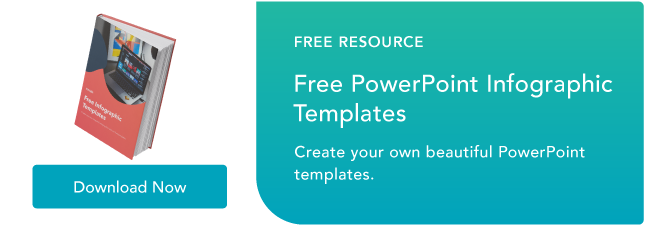Did you know that people retain 65% of the information they see, but only 10% of the information they hear?
Also, people follow directions 323% better with a combination of text and illustration than instructions without illustrations.
That's why, as a marketer, it's important to display information in a combination of visual and text, in an easy-to-consume way.
A great way to do that is through infographics.
If you've wanted to create and publish an infographic, you've come to the right place. I know you might be thinking, "I'm not a graphic designer" or "I've never made an infographic before." But you're not alone.
And that doesn't mean it can't be easy for you to learn.
In this post, we'll take you through everything you need to know about infographics, from what they are to what kinds of infographics there are to how to promote an infographic once you've created it.
Table of Contents
- What is an infographic?
- Infographic Examples
- Infographic Dimensions
- Infographic Ideas and Topics
- Infographic Tips
- Infographic Templates
- How to Share an Infographic
What is an infographic?
An infographic is a visual graphic that explains a concept or data. It's a way of presenting information with text in a visual medium. The idea is to use images, charts, and minimal text to understand an idea.
Infographics typically use engaging visuals to quickly and clearly communicate what the graphic is about.
People use infographics because they can provide a quick overview of a topic, explain a complex process, and display data easily. Infographics are also great for comparing two opposing concepts or ideas.
As a marketer, you might've experienced the feeling of indecisiveness when you want to create a marketing asset for a campaign, but you're not sure the best way to disseminate the information. Is your idea best suited to a blog post, YouTube video, or social media post? The great news is that for any medium, in any industry, you can use infographics in your marketing.
Infographic Examples
1. What is Guerilla Marketing, by Invite Referrals
Below is a great example of an infographic by Invite Referrals, which focuses on describing guerilla marketing. Instead of making a blog post or video, the company decided to explain, in detail, the concept of guerilla marketing in an infographic.
With an infographic, the information is easier to digest because it uses succinct copy and visuals to help get the point across.
Additionally, this infographic has a clear headline that communicates what it's about, so readers can instantly tell what they're going to get from reading it.

2. Small Business and Marketing, by SEO.com
This is another excellent example of an infographic because it uses a combination of data and visuals to give information on small business marketing.
The creator, SEO.com, also broke down the information into sections, so readers can easily scan the graphic and see what information they want quickly.
One of the ways this graphic excels is that it knows its buyer persona. SEO.com, a site to help marketers, made this infographic that directly targets small business owners and marketers.

3. Video Marketing, by Visual.ly
In this example, Visual.ly uses data and visuals to communicate why video marketing is important. Additionally, the company uses bright colors to attract attention. If someone is scrolling social media, the color and design might make them stop to see what the graphic is about. It pulls the reader in.
With an infographic, you can hook readers with the visual design and communicate an idea in a way that doesn't take up too much of your audience's time.
Again, the concise copy and visuals will help readers get interesting information right away. And this information is exactly what marketers might want to learn about.

4. Modern Marketer, by Get App
This is an excellent example of an infographic because it uses concise copy and engaging visuals to communicate information.
My favorite element of this infographic is how it's visually easy to understand and you can see the hard and soft skills of being a modern marketer without needing to dive into the topics. This is a quick, easy-to-scan infographic, which is what marketers are looking for when they're working.

5. Content Marketing, by Ditto Digital
Another great example of an infographic is by Ditto Digital. This infographic focuses on giving tips to content marketers. What I like about this example is that the copy is easier to read than a blog post on the same topic might be.
The copy is concise and the visual elements of headers and subheaders make it easier to read. Additionally, this is visually interesting and has several graphics to pull your attention.

Infographic Dimensions
So, now that you know what an infographic is and have seen some examples, you might be wondering how to get started with your own infographic.
Before you can jump into designing, it's important to understand what size your infographic should be.
The answer is that it depends on where you're going to promote it. Below are the most common places you might post an infographic with the recommended sizes:
- Facebook: 1200 x 628 pixels
- Pinterest: 600 x 900 pixels
- Website/Blog: 600 x 1800 pixels
- Twitter: 1200 x 675 pixels
- Instagram: 1080 x 1080 pixels
- LinkedIn: 1104 x 736 pixels
Infographic Ideas and Topics
- Comparison Infographics
- Marketing Infographics
- Process Infographics
- Timeline Infographics
- Statistical Infographics
1. Comparison Infographics
A comparison infographic is an infographic that compares two ideas. Infographics are a great way to compare and contrast because you can visually see things side by side.
Below is an example of a comparison infographic which compares bad posture with good posture. Not only can you visually see the difference, but you can also read the copy which explains how posture can impact your health, feelings, communication, and appearance.

2. Marketing Infographics
A marketing infographic is a graphic whose main purpose is to build awareness for a brand and boost engagement.
With a marketing infographic, you can showcase business achievements, deliver news, display a new product or service, improve a course with handouts, drive interest on social media, show data, present quotes, summarize key points in a blog post, and more. The options are honestly endless.
Really, infographics can be used for anything. Whenever you're thinking about creating a marketing asset, consider whether an infographic will help prove your point.
3. Process Infographics
A process infographic simplifies and explains the steps of a process in primarily visual terms.
Generally, it illustrates what happens during each step or phase with an intuitive layout that's easy for the viewer to follow from start to finish.
A well-designed process infographic makes the concept you want to share more accessible and saves you and the audience time.
Below is an example of a process infographic which explains the process of mechanical recycling.

4. Timeline Infographics
A timeline infographic is a way to quickly communicate important information — from key dates in your company's history to upcoming project milestones or predicted market trends.
This type of infographic is what you would use if you were planning a product launch for example. Or perhaps you want to communicate a timeline of your business achievements for your website.
Featured Resource: 8 Free Timeline Templates for Business
5. Statistical Infographics
A statistical infographic is a graphic whose main purpose is to show data and research. Let's say that your company has first-party data about your industry. What better way to communicate that than with an infographic?
Now that we know what types of infographics there are, let's give you a few tips on the process of creating one.
Infographic Tips
- Find resources.
- Target your buyer personas.
- Keep it focused and simple.
- Use visuals.
1. Find resources.
Before you start creating your own infographics, look for resources that can help you. This is particularly helpful if you aren't working with a graphic designer.
For example, you can use PowerPoint templates or Canva templates. In fact, there's really no shortage of design resources -- charts, reports, and infographics. And, depending on your budget and needs, there are a plethora of options available, all of which have their pros, with very few cons.
2. Target your buyer personas.
When we went through the examples above, you might've noticed that I commented on infographics that correctly targeted their audience. With any marketing asset, it won't accomplish what you want if it's not created for the correct buyer persona.
Don't forget what the purpose of marketing is: to deliver the right message to the right audience at the right time.
3. Keep it focused and simple.
Infographics are a great way to stay focused and use simple language to communicate a message.
The best messages are succinct and very specific to the audience. That's why your infographics should be as focused and simple as possible.
As a marketer, it's important to simplify your messaging whenever you can. Simple messages are easier to understand and retain.
4. Use visuals.
Of course, you can't have a great infographic without visuals. In fact, the whole point of an infographic is to communicate a message with both text and visuals.
The goal of the visuals should be to hook the reader and make it easier to digest the information. And you don't have to be a graphic designer to accomplish this.
In fact, you can use premade templates to make your life easier. Below let's go over why templates are useful.
Infographic Templates
Infographics are a powerful tool for capturing the attention of your target audiences. In fact, businesses that publish infographics grow their traffic an average of 12% more than those that don't.
The hard part, of course, is finding time and resources to create these infographics. That's why HubSpot created fifteen fully customizable infographic templates that will give you the inspiration and foundation you need to build your own infographics right in PowerPoint or Illustrator.
Use these infographic templates to present data for your next meeting, promote an offer on social media, or in your next blog post. Visual information is becoming more and more popular -- and now you have the resources to easily create this visual content.
Featured Resource: 15 Free Infographic Templates in Powerpoint (+5 Bonus Illustrator Templates)
How to Share an Infographic
- Optimize your infographic for search engines.
- Find websites and blogs that share similar infographics.
- Share infographics with the right bloggers and influencers.
- Submit your infographic to infographic directories.
- Promote through all your digital marketing channels.
1. Optimize your infographic for search engines.
Infographics don't go viral by accident -- even if you've got the best infographic in the world.
Instead, strategically promoting your infographic by identifying the right people and the right websites can get your infographic in front of thousands of people fast.
But before we do that, you'll want to make sure to optimize your infographic for search engines. SEO won't necessarily help your infographic go viral, but it's extremely beneficial because it will help increase your search engine rankings (which means more free traffic to your website).
Check out this infographic by Backlinko to help guide you while you're optimizing your infographic(s) for search engines:

2. Find websites and blogs that share similar infographics.
For example, if I had just published an infographic on email marketing, I would go to Google at type in: "Email marketing infographic." What you're looking for are websites and blogs that have published similar infographics made by other people.
After you've got a decent list of websites that you think will be willing to share your infographic, it's time for some email outreach. First, start by identifying the authors from each of the websites that published similar infographics. You can usually find the author's name in the article's byline:

Once you've got a list of authors, use a tool like Viola Norbert or ContentMarketer.io to find email addresses so you can start sending personalized emails.
If you want to learn how the pros do email outreach, check out this article from Brian Dean at Backlinko. Part of that case study highlights the "Pre-Outreach" and "Content Roadshow" strategies he used to generate buzz for his content.
For example, check out Emil's 2-step approach to email outreach. Instead of doing what most people do and asking for a backlink or share right away (1-step approach) here's what he did:

And because he wasn't being pushy, he gets responses like this from people asking to send his content over (2-step approach):

See the difference?
Now I'll be the first to admit that email outreach is not the most exciting part about infographic marketing -- but it's crucial if you want to get more eyeballs on your work.
Plus, the long-term benefits from the relationships you'll build with influencers and bloggers will become invaluable down the road.
3. Share infographic with the right bloggers and influencers.
The best tool to find these influencers is BuzzSumo. Just type in a topic or copy/paste a specific link to pull up content that is sorted by number of social media shares.
For example, if I were doing an infographic on gardening, I'd type in "gardening infographic" into BuzzSumo. Next, I would go through the results one by one and click "View Sharers" on any infographics that are similar to mine:

This will give you a list of the people who have shared that infographic, which is helpful because you can sort by number of followers to identify influencers with a large number of followers who have shared infographics that are similar to yours.
Like in the last step, find their email address and start reaching out one-by-one. Aside from Viola Norbert and ContentMarketer.io, another clever way to find someone's email address is to subscribe to their blog -- the welcome email and all future emails should come from an address that you can respond to.
As an alternative, if you can't find someone's email address, you can always use Twitter to reach out publicly:

Sam Hurley has hundreds of thousands of followers but still responded and shared content from Brian Downard:

See how he used the same 2-step outreach approach like the email example from above? He asked if they wanted to see it and then sent the link afterward.
Not being pushy is the key to getting responses and getting your content shared. You might also consider sending a friendly "thank you" note after an influencer shares your content to strengthen the relationship:

4. Submit your infographic to infographic directories.
These directories are basically websites that curate infographics for other people to see. And they are the perfect place to get your infographic discovered by people who might want to share it on their website.
Trouble is, there are dozens of these directories out there, so instead of manually doing each one by yourself, I recommend using Fivver to pay someone to do it for you. You don't need to have someone submit your content to 50+ directories -- just stick with the people who only add it to the top 10-30 infographic directories.

5. Promote through all your digital marketing channels.
Once you've added your infographic to the right directories, share it through all of your marketing channels:
- Share with your email lists
- Schedule multiple social media posts
- Paid ads / remarketing ads
- Add links to infographic on relevant website pages
- Share with industry partners
- Send to influencers/bloggers who've shared your content in the past
- Share with any brand or person you mentioned in your content
Infographics are a valuable resource that marketers can use to communicate with their audience in an easy-to-understand way. Next time you're coming up with content, consider if an infographic is a better way to communicate your message.





![Here's I create the perfect project timeline. [Template + Examples]](https://www.hubspot.com/hubfs/project-timeline-template-1-20240919-3074583.webp)

![How To Create An Infographic In PowerPoint [+Free Templates]](https://www.hubspot.com/hubfs/Untitled%20design%20%2885%29-2.png)





